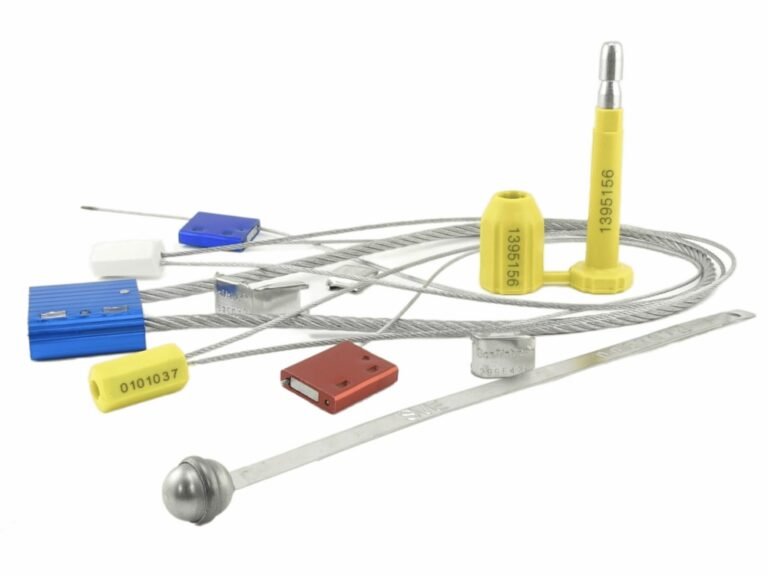A critical blood sample is questioned for contamination because it arrived in a simple Ziploc. A distressed patient claims their watch was stolen from a standard belongings bag. Both situations create a liability nightmare for your facility.
The solution isn't a stronger lock; it's the right type of container. Security seals protect large, existing containers, but tamper-evident bags are all-in-one secure containers for individual items, providing an integrated record and undeniable proof of integrity.
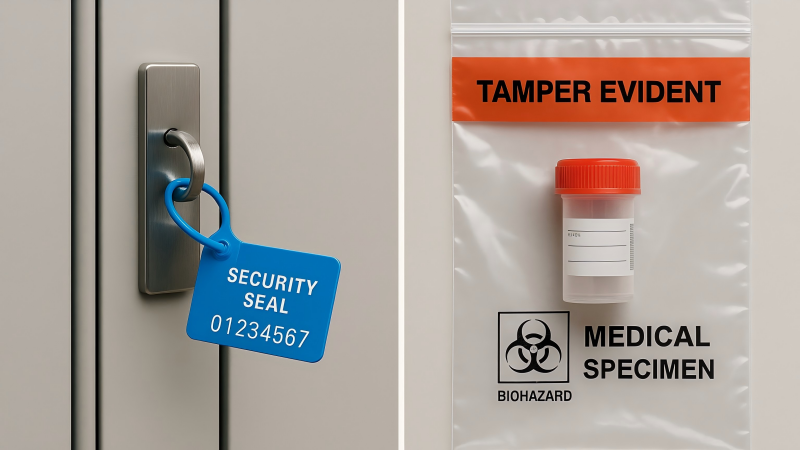
I often have to clarify a key point with my clients: security seals and tamper-evident bags solve two completely different problems. A seal is designed to protect the integrity of a container—a cart, a cabinet, a door. But a tamper-evident bag is the container itself, one that integrates security, containment, and information recording into a single unit. Your choice shouldn't be based on which is "more secure," but on the physical nature and journey of the asset you're protecting. In other words, when you need to secure a door or a cart, use a seal. When you need to secure a loose, individual item that needs its own documented journey—like a document, a blood sample, or a patient's phone—the tamper-evident bag is the only professional choice.
For Specimens: When Is a Bag Essential for Sample Integrity?
A lab tech receives a urine sample in a standard container with a loose lid, creating doubt about its integrity. The test results are now legally and medically questionable, forcing a painful and costly re-collection.
Use a tamper-evident bag when sample integrity is non-negotiable. The bag's permanent closure and unique tracking number create a sealed, documented micro-environment, providing undeniable proof that the specimen is sterile and unadulterated from collection to lab.
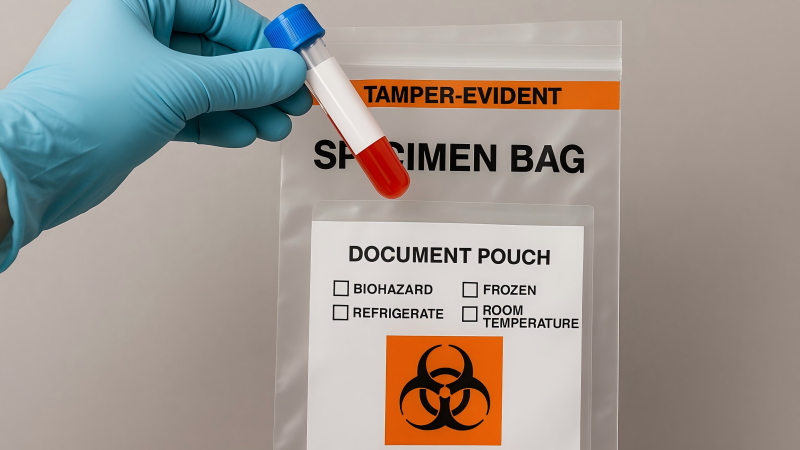
When you are dealing with biological specimens, you are not just securing a thing; you are preserving the integrity of critical medical data. A seal on a cooler full of samples protects the cooler, but it doesn't protect the individual samples from cross-contamination or tampering within the cooler. A tamper-evident specimen bag solves this by making the container part of the sample's identity. Features that make this possible include:
- Aggressive Permanent Adhesive: Once sealed, the only way to open the bag is to destroy the closure, leaving obvious evidence.
- Unique Serialization: Each bag has a barcode and human-readable number, creating a direct link between the physical sample and its record in your LIS (Laboratory Information System).
- External Document Pouch: The lab requisition form travels with the specimen but outside the sealed compartment, preventing contamination of the paperwork and ensuring all information arrives together.
This turns the specimen and its documentation into a single, secure unit, forming the first and most crucial link in a valid chain of custody.
Patient Valuables: How Do Bags Limit Hospital Liability?
A patient is admitted and hands over their wallet and phone. Upon discharge, they claim $200 is missing. With no proof, your hospital is caught between a potential financial loss and significant reputation damage.
A serialized patient property bag is your primary tool for limiting hospital liability. By sealing valuables in a numbered bag in front of the patient and giving them a matching tear-off receipt, you create a documented and mutually-agreed-upon transfer of custody.
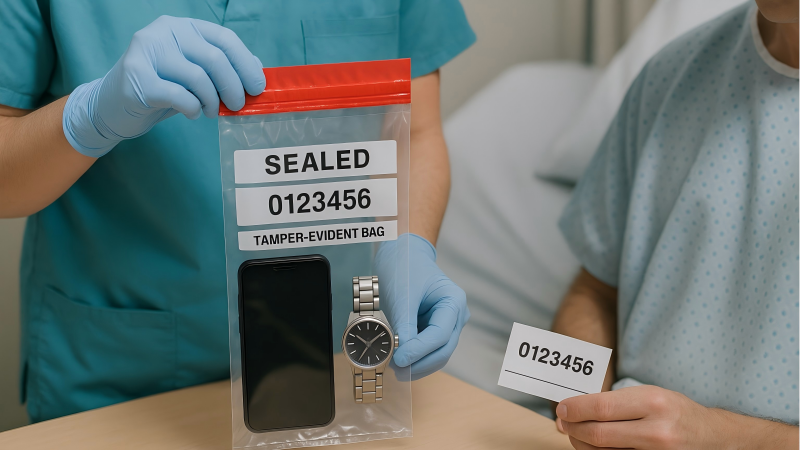
Hospitals are responsible for safeguarding patient property, and this responsibility is a major source of risk. A simple drawstring bag or locker offers weak protection and even weaker proof. A tamper-evident property bag transforms this informal process into a professional, legally-defensible one. The process is a critical part of hospital risk management:
- Inventory: The items are placed in the bag in full view of the patient.
- Seal: The bag is sealed using its permanent adhesive strip.
- Sign: Both the staff member and the patient can sign across the sealed area.
- Document: The unique serial number is recorded in the patient's file.
- Receipt: The patient is given a tear-off receipt with the matching serial number.
Now, if the patient receives the intact, sealed bag upon discharge, any claim of loss during their stay is nullified. The bag isn't just a bag; it's a signed contract that protects both the patient and the facility.
Transfers: Why Are Bags Superior for Moving Items Across Departments?
A critical biopsy sample needs to move from the operating room to the pathology lab on another floor. If it's just placed in a cooler, who is to say it wasn't accidentally opened or delayed in a hallway?
For any multi-step transfer, a tamper-evident bag acts as a "passport" for the item. Its sealed, serialized nature ensures that the item's integrity is maintained and verifiable at every handoff point across departments or even between different facilities.
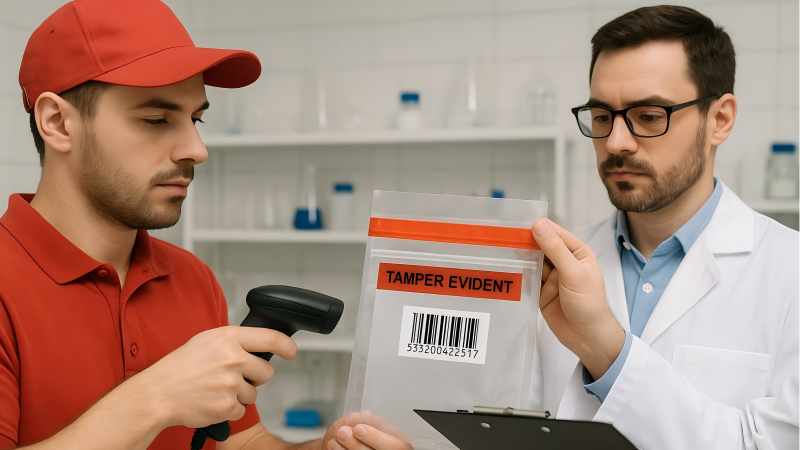
Think of the journey a specimen takes: from the patient's bedside, to a local processing area, to the main lab, and sometimes to an external specialty lab. A simple seal on an outer transport box can only tell you about the box's final state. It tells you nothing about what happened at each intermediate step. A tamper-evident bag, however, protects the actual asset throughout its entire journey. The bag's unique barcode can be scanned at every single handoff. This process creates a detailed, time-stamped digital trail. If a delay or anomaly occurs, you can instantly pinpoint where in the chain it happened. This level of granular tracking is essential for adhering to strict specimen handling guidelines and ensuring traceability.
Chain of Custody: How Do Bags Create a Documented Trail?
Your logbook shows Seal #4567 was used, but what was it sealing? And who witnessed it? A seal number alone lacks the context needed for a strong audit trail.
Tamper-evident bags are designed to be an all-in-one documentation system. They integrate the serial number, a write-on surface for content details, and a secure closure into a single object, creating a complete and self-contained evidence package.
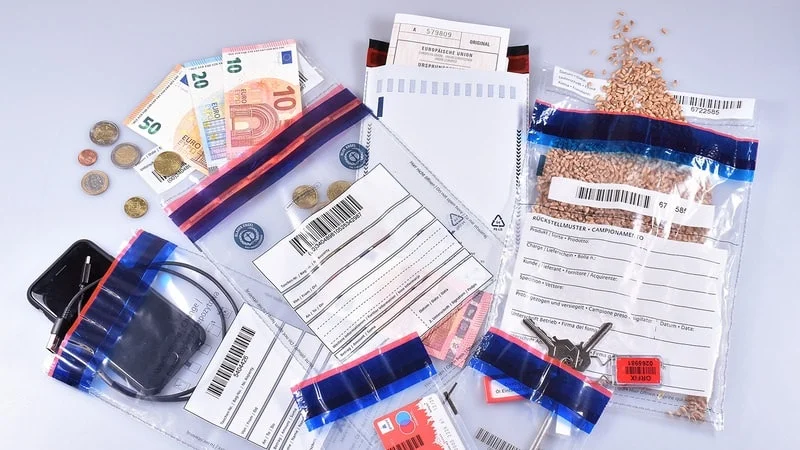
A strong chain of custody requires more than just a number; it requires context. This is where bags offer a fundamentally superior workflow for loose items compared to seals.
| Feature | Security Seal | Tamper-Evident Bag |
|---|---|---|
| Identifier | Unique Number | Unique Number + Barcode |
| Information | Relies on a separate, external logbook. | Integrated write-on surface for patient ID, contents, dates, and signatures. |
| Receipt | None. | Often includes a tear-off receipt with matching number for the patient or sending unit. |
| Unit of Custody | The container (cart, cabinet). | The item itself. |
This integrated design means you are not just tracking a seal; you are tracking a specific item with all its relevant metadata physically attached to it. For any process requiring forensic levels of evidence, the bag provides a much stronger and more comprehensive audit trail.
Visual Proof: What Makes a Bag's Tampering Evidence So Clear?
A clever thief can sometimes manipulate a simple security seal, perhaps by heating the plastic or carefully gluing it. This can pass a cursory inspection, giving a false and dangerous sense of security.
High-quality tamper-evident bags utilize multi-layered security features, like specialized "VOID" tape, that produce an irreversible and vividly clear visual indicator if any attempt is made to open the bag.
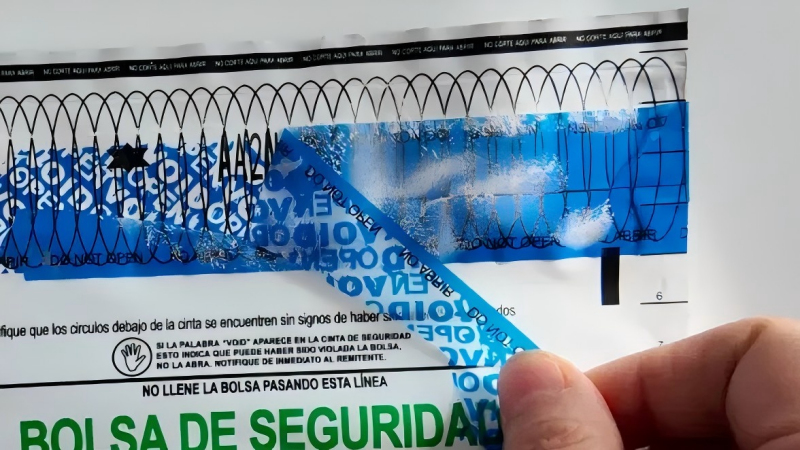
The most advanced tamper-evident bags are designed to fail spectacularly and obviously. They don't just break; they transform in a way that is impossible to hide. The key technology is often referred to as "voiding" adhesive. Here's how it works:
- The Initial Seal: The adhesive strip is applied, and it looks clean and uniform.
- The Tamper Attempt: Someone tries to peel the tape back, even very slowly or with heat.
- The Irreversible Change: The adhesive layer itself separates, leaving a hidden graphic or word—typically "VOID" or "OPENED"—both on the bag's surface and on the tape itself.
It is impossible to reseal the bag without this graphic showing. This feature eliminates ambiguity and makes tampering attempts "scream" for attention, providing clear, indisputable proof of a breach.
Conclusion
The choice is clear: use security seals to protect your large containers and cabinets. But for the individual items that move through your facility—from specimens to patient valuables—a tamper-evident bag is the only professional tool that provides containment, security, and a complete chain of custody in one unit.
The Right Container for Every Asset from ProtegoSeal
Whether you need to secure a room or a single blood sample, using the right tool is essential for safety and liability. ProtegoSeal offers a full range of security solutions, including high-integrity tamper-evident bags for all your clinical needs. Contact us to ensure every asset in your facility is properly secured.

